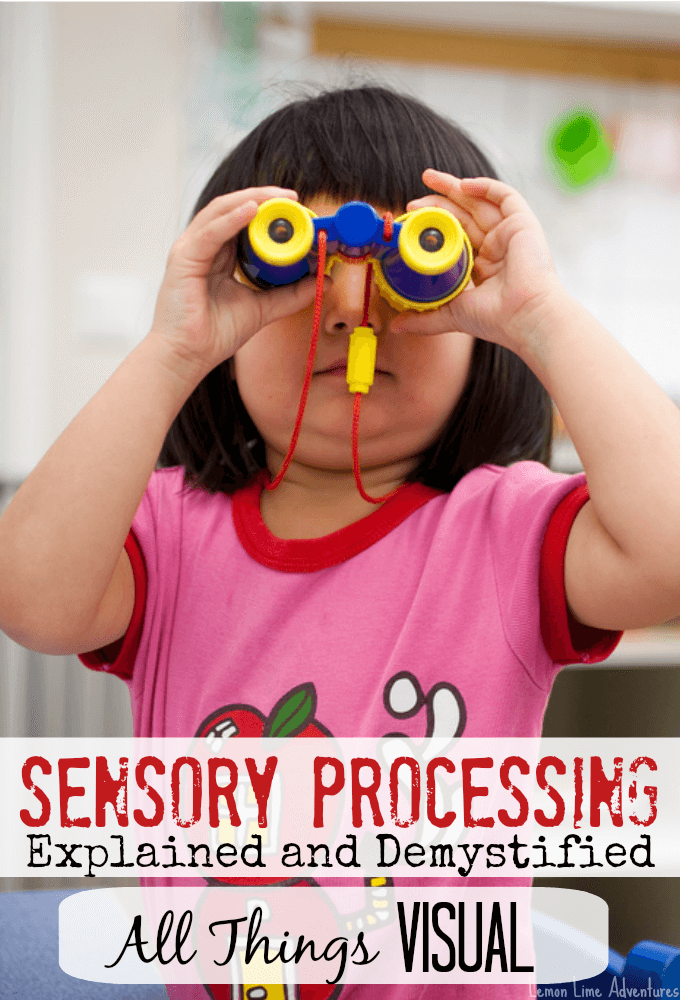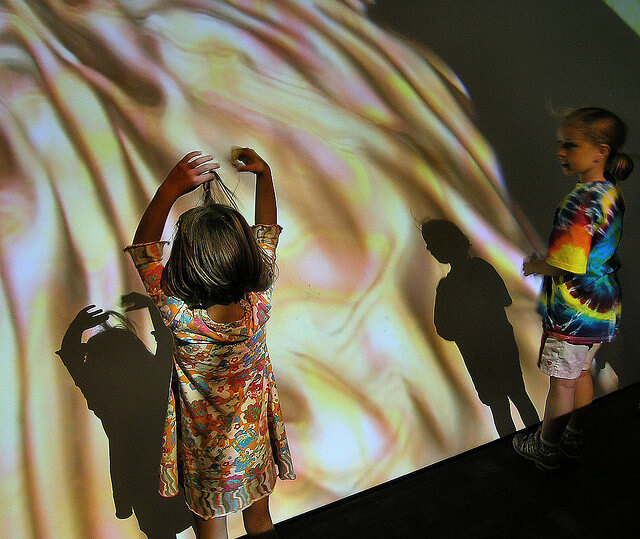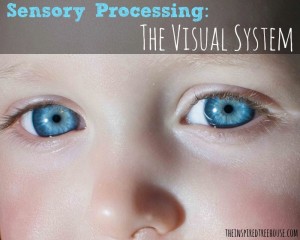Growing up I learned that we had 5 senses that helped us understand the world around us. I was taught about what these senses were and what part of my body was responsible for making them happen. What I didn’t learn was how vital and important their interaction and integration was. That is why I am excited to join with my friends at The Inspired Treehouse, a group of pediatric physical and occupational therapists, to bring you this series on all things Sensory Processing. This month we are talking about Visual Input and its importance for growth and development in kids.

{THIS POST MAY CONTAIN AFFILIATE LINKS TO MATERIALS I RECOMMEND. ANYTHING YOU PURCHASE THROUGH THESE LINKS HELPS SUPPORT LEMON LIME ADVENTURES. THANK YOU IN ADVANCE FOR CHOOSING TO SUPPORT US.}
Just like last month, I will attempt to explain an aspect of Sensory Processing from my perspective. I will not attempt to use medical terms, explain what I don’t understand myself, or pretend to be an expert. My good friends, at The Inspired Treehouse, will bring you their take on the same topic, giving you a better understanding of Sensory Processing.
REMEMBER:
I am not a therapist or a doctor.
I am, simply, a mom raising a child with sensory needs.
I am, simply, an educator who taught in Early Childhood Education for 12 years.
I am, simply, just like you.

The Visual System is pretty self explanatory. Even if you are not familiar with Sensory Processing, you have probably heard the term, Visual Input. It is one of the first systems we are taught about in school. We are taught to use our sense of sight to see, observe, and make connections. However, we aren’t always taught the importance this system plays in our body’s ability to feel in control and centered. In fact, I think it is one system that can go widely overlooked because it seems so basic and “black or white”.
If I had to define the The Visual System without using medical terms, I would define it as our bodies ability to make sense of the world using our sense of sight. It is our bodies way of taking in information about our surrounding to help us gauge if they are safe, harmful and even whether they are important to notice or not. It isn’t simply about our ability to see (20/20 vision), but out ability to track, locate, and discriminate things around us.
Determining the tint of our shirt to wear for the day, finding our socks in the sock drawer, tracking the teacher as she walks around the room. All of these things require us to use our sense of vision to be successful day to day. If I had to define this system with one word, I would use…
SEEING
Without a regulated visual system, we are unable to focus on the important details that help us understand the world around us and the environment we are in. Currently, I am surrounded by books, pens, my water bottle, some loose papers, and a left over snack. Because my visual system is in tact, I am able to still focus on the computer screen and write these these words. Because of my visual system, I am able to focus in and decipher which items surrounding me are important, and which ones can be ignored.

NOTE: I want to be completely honest, and state that I am not completely clear on the visual system and its affects on children. I am going to attempt to explain it to the best of my ability and share stories from my life as an educator and as a mom, raising a child with sensory processing.
If you are like me, you are wondering what this all means. What does this look like and why is it important?
As I mentioned before, Visual Processing is not just about sight and seeing colors, shapes and sizes, but about processing the the visual environment surrounding us. All children require this awareness and input for proper development. The list of skills associated with visual processing is long and exhaustive. Just to name a few, the visual system is responsible for letter/number recognition, peripheral vision, spatial relationships, hand/eye coordination, reading and pre-reading skills, focus, and attention to detail. The problem occurs when a child is either over or under responsive to receiving information from this system.
But here is where it gets tricky. Sometimes it can be difficult to detect that a child is under or over responsive to visual input.
As an educator, I vividly remember the kid I had in my class that would never look me in the eye. In fact, she would cover her eyes as I was talking to her or whenever something important was happening in the classroom. At first glance, it seems like a disrespect. It seemed as though she didn’t care at all about what I was saying, when in fact she was overstimulated and most likely needed some of the visual stimulus to be removed.
Then on the other hand, there were those kids that just stared. Not at me… out the window, at the bright lights, at the flickering florescent light. The seemed to fixate on it. These were the same kids drawn to the light table during center time, and would get overly protective of that space if another child tried to join them.

I know that all parents struggle with their children locating and finding things. I know this is a “normal” problem to have. However, in our house Legoman struggles with this on a whole other level. We used to joke around and call him “Snake Bight”. We thought it was funny that he was incapable of finding anything in the mix of this things, until we realized the problem was much more severe. When a child is looking for a shoe or a sock, you don’t worry as much… however, when it starts to affect the way he functions on a day to day basis, you realize that they might need help in this area.
I know I have told you this before, but did you know that my son did not look me in the eye until he was 7 years old. Even to the day, we struggle with eye contact and getting our son’s full attention. Often times, we are overlooked, our facial expressions that depict the mood we are in, and our instructions are completely missed.
Legoman is a visual seeker, meaning he is constantly looking for things that are visually stimulating to help regulate his nervous system. Unfortunately, this means he desires the television and video games. I am not opposed to giving him electronic time, in fact, we encourage some. The problem comes, when we “unplug” Legoman. It started a long time ago, we noticed that anytime he had visual input for a prolonged period of time, it would greatly affect his mood. Saturday morning cartoons are something we have never heard of in this house, because we know just how awful the day could be after a morning of cartoons.
We struggle with finding the balance, since the visual stimulus is something he seeks and desires, but the rest of his systems completely shut down when he is “plugged in”. What we do know, is that if we want to get his full attention, we need to remove all visual stimulus, we need to get down on his level and make sure he knows are are talking to him. We have to be completely aware at all times of his surroundings and he has in his environment.
Remember, Sensory Processing is Complex. It is different for every child, because every child is unique. The problems arise when a child either seeks or avoids auditory input. For your convenience, I have compiled a Visual Input Cheat Sheet Printable listing behaviors you might see if your child is with avoiding or seeking this type of input.
Now its time to hop over to my good friends at The Inspired Treehouse, where they are sharing their tips as Pediatric therapists to explain the Visual System and why they feel it is important to the growth and development of all children.

Visual Sensory Activities from Sensory Activities for Kids
Follow Dayna :: Lemon Lime Adventures’s board Sensory Processing Resources on Pinterest.
Follow Dayna :: Lemon Lime Adventures’s board Sensory Play on Pinterest.
Do you know a child that seeks or avoids Auditory Input? Do you have a child with sensory needs? Has this post touched you in some way? I would love to know! Please send me a message or leave a comment. It helps when we know we are not alone.
Click the picture below to join our Support Group for Sensory Needs.
DID YOU ENJOY THIS POST? READ MORE FROM THIS SERIES
Sensory Processing | Tactile | Vestibular | Proprioceptive | Auditory
Make sure you don’t miss the next in the series about Sensory Processing. Follow me on Facebook, Twitter, Google+, Pinterest, Instagram or subscribe by email in the sidebar.










Pingback: The Inspired Treehouse
Pingback: Sensory Bottles | The What, Why & How - Lemon Lime Adventures
Pingback: 10 Sensational Pool Play Ideas
Thank you, thank you, thank you. I have been voraciously gobbling up any information I could since my son has been diagnosed with SPD. He tested in the less than 1% for visual perception. Honestly, when I realized how hard it was for him to have any type of form recognition, I am amazed that he has learned to read. I can find tons of information to help him with his input seeking when it comes to his vestibular, perioceptive, and touch needs, but hardly anything for visual input. Thank you!
and when I say “perioceptive” I actually mean “proprioceptive.” That’s what I get for commenting on blogs late at night. 😉
Pingback: What Is Sensory Processing? - Lemon Lime Adventures
Pingback: What is sensory processing and how can I understand my child? - Wildflower Ramblings
Pingback: What is the Visual Sensory System? - Melissa & Doug Blog
Pingback: A Hidden Reading Problem: Eye Tracking - Hand Made Kids Art
Pingback: Vestibular Input: Sensory Processing Explained - Lemon Lime Adventures
Pingback: Tactile Input: Sensory Processing Explained - Lemon Lime Adventures
Pingback: A-MAZE-ing Sensory Friendly Valentine Printable - Lemon Lime Adventures
Pingback: Sensory Benefits of Water and Pool Play - Melissa & Doug Blog
Pingback: Simple Breathing Exercises to Calm an Angry Child
Pingback: Proprioceptive Input: Sensory Processing Explained
Pingback: Don't Call My Kid a Cry-Baby! | Stir The Wonder